The Herault
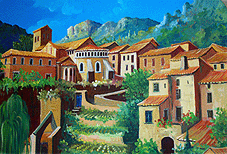 Northeast of the Montagne Noire lies the Herault, a beautiful area with many historical remains, a gorgeous natural beauty and popular beach resorts. The capital is Montpellier, followed by Béziers and the popular towns of Lodève, Agde and Sete. In the west lies the Parc Naturel Régional du Haut Languedoc with its beautiful mountains, forests, rivers and lakes. The dryer coastal area is littered with medieval towns and abbeys. You can go horseriding, walking, golfing, swimming and paragliding almost everywhere. In the northeast of the Herault you enter the Petite Camarque, a swamp area where flamingos and wild horses live. In short, the Herault is for everyone.
Northeast of the Montagne Noire lies the Herault, a beautiful area with many historical remains, a gorgeous natural beauty and popular beach resorts. The capital is Montpellier, followed by Béziers and the popular towns of Lodève, Agde and Sete. In the west lies the Parc Naturel Régional du Haut Languedoc with its beautiful mountains, forests, rivers and lakes. The dryer coastal area is littered with medieval towns and abbeys. You can go horseriding, walking, golfing, swimming and paragliding almost everywhere. In the northeast of the Herault you enter the Petite Camarque, a swamp area where flamingos and wild horses live. In short, the Herault is for everyone.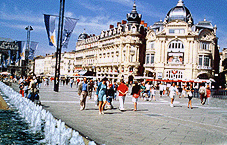 Montpellier
MontpellierMontpellier is the capital of the department Herault and of the region Languedoc Roussillon. It is a regional metropolitan city, which developed in the Middle Ages when two smaller towns melted together as one. In 1196 a wall was built around the town. There are still a few remains of this period in the center of the city, such as the Tour de la Babote and the Tour des Pins. In the early 13th century, Montpellier belonged to the Spanish realm of Aragon. It received autonomy under the reign of a consul. In 1349 the city was sold to the French kingdom. During the Religious Wars, all churches were demolished. After the end of the wars, Montpellier became the capital of the Languedoc.
In the 17th and 18th centuries, many buildings were built in the city to give it the feel of a capital. Squares were built, beautiful houses were built to suit the richer inhabitants and also the viniculture developed into a large source of income in the 19th century. When Montpellier, after the slicing up of the Languedoc in 22 regions, became the capital of the Languedoc Roussillon, the city gained much prestige.
The sights are mainly in the old medieval town. The highest point is the Promenade Royale du Peyrou, situated on the western side of the old town. Here you can see an 18th century water tower and an equestrian statue of Louis XIV. The triumphal arch stands on the site of the old city wall.
The cathedral of St. Pierre was rebuilt in Gothic style in the 17th century, after it was damaged during the Religious Wars. Interesting is the first open landing (stair house) of the Languedoc, in Hotel de Mirman. It is a Gothic style mansion from the 13th century, but when it was renovated in the 17th century, it gained as a first an open landing, which was quickly picked up on and it became a fashion for a while in the area. Just down the road is the Jewish bath house the Mikwe, which is about 800 years old.
You can enjoy looking at some fine art in the Musée Fabre, where many beautiful paintings are exhibited. But when you want to go shopping, go to the Place de la Comédie. Here you will find a large car-free shopping area which runs north into a modern shopping mall called Le Polygone.
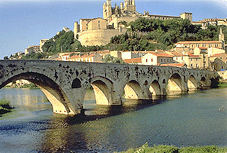 Béziers
BéziersIn Roman times, Béziers was situated on the Via Domitia, which runs from Rome to Spain. Therefore it was an important Roman city. In the Middle Ages, Béziers was a commercial city. In 1209 it became the most important city of the county of the noble family Trencavel. Also Carcassonne belonged to this county. In this year, Béziers was besieged by the armies of king and pope, who were bound to kill all Cathars and conquer the Languedoc. Béziers wasn't a particular Cathar city, but the Inquisition wanted to make an example. On 22nd July, on the name day of Mary Magdalene, thousands of people were killed brutally when the city was taken. When someone asked how to recognize Cathars from Catholics, they said: "Kill them all, God will recognize his own". This massacre was a tremendous shock which made the Languedoc tremble upon its grounds. It was not just a battle between Catholics and Cathars, it was also the beginning of the battle between the Languedoc and the French kingdom. All people who thought differently were doomed. This went for not just the Cathars, but also the Jews and other non-Christian people. When Béziers fell, it was annexed into the French kingdom. Also during the Religious Wars between Catholics and Protestants, Béziers was damaged terribly. But finally the city, after licking its wounds, crawled back up and especially thanks to the Canal du Midi, viniculture became very prosperous. Thanks to the Canal, the wine could be shipped and traded quickly.
Today Béziers is visited by many tourists. Interesting are the locks at Fonséranes. Here, seven locks overcome a height of 21,50 meters. The center lies on a rock, on which the cathedral stands, which dominates the town. The cathedral, which was dedicated to St. Nazaire, was badly damaged in 1209 but rebuilt in the 13th and 15th century. From the square in front of the cathedral, you have a wonderful view over the town and the Orb Valley. The promenade Allées Paul Riquet, named after the baron who managed to materialize the Canal du Midi, has succeeded in keeping its 19th century charm.
When you take the D19, you can drive to the Mediterranean coast, where you can escape the heat in for example the beach resort of Valras Plage. But also the Orb Valley with its river and woodland offers coolness. In the mountains deeper inland, you can discover wonderful old towns.
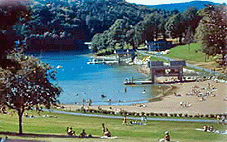 Le Plateau des Lacs
Le Plateau des LacsIn 1973, the Parc Naturel Régional de Haut Languedoc was founded. The park covers the eastern part of the Tarn and the western part of the Herault. It is 145.000 acres big. The area lies exactly on the division of the waters: the waters which flow towards the Atlantic Ocean and the waters that flow towards the Mediterranean Sea. This also goes for the climate, it both enjoys warmer and sunnier weather thanks to the Mediterranean coast, and gets sufficient rain thanks to the Atlantic coast. Therefore, the area is rich in forests, rivers and lakes. South of Lacaune le Bains, around the lovely town of La Salvetat sur Agout, there are two popular lakes which came into existence because of two dams. The water is therefore always clear and the beaches on the lakeshores are busy with sunbathers every Summer. There are several water sports possible and in the surrounding area there are many splendid walks. There are also several possibilities to go horseback riding.
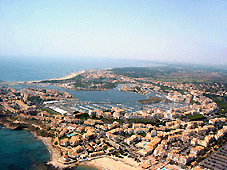 Agde
AgdeThe area around Agde was already colonized by Greek settlers from Crete, but also by settlers from Egypt and Phoenicia. Around 500 B.C., Greek colonists from Phocaea founded the city Agathè Tychè (prosperity). This was the beginning of Agde. The town of Agde lies on the slopes of an old vulcano and many buildings were therefore built using basalt stone. There are still some remains of the Greek period visible today. In the 5th century, Agde became a Bishopric. In the 9th century the cathedral of St. Etienne was built. Interesting sights are e.g. the musée Agathois, with a nice collection of paintings, costumes, art, archeology and pottery which was unearthed in the area, the Chateau Laurens (art Nouveau) and the subterranean ice storage from the 17th century near the city wall. Also pay attention to the interesting doors from the 16th to the 18th century.
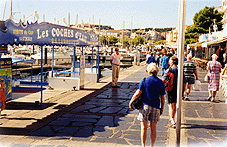 Cap d'Agde
Cap d'AgdeCap d'Agde was hardly inhabited until the sixties of the 20th century. It was merely another cape in the Mediterranean. But in the seventies, when people discovered the beaches near the cape, the first districts were built. Today, Cap d'Agde has the biggest capacity to house tourists in the Languedoc. Apart from the huge offer in entertainment, there are also several attractions. First of all the Musée de l'Ephèbe, where you can see a world famous bronze statue from the 4th century. The theme of the museum is underwater archeology. In the Sea Aquarium there are many beautiful and colorful fish and other sea animals. In the natural reserve on the Pic Saint-Loup is the Tour des Anglais, which was built in the 17th century to keep an eye on the English and threatening pirates. The hill which forms the center of the park is an ancient vulcano, which erupted for the last time about 750.000 years ago.
Pézenas
In Roman times, Pézenas was situated on the Via Domitia. After it was annexed to France in 1262, it received city rights in 1273 and became an important market town. The main product was wool. In the 16th and 17th century, Pézenas became the most important city in the Languedoc. They had the honor to accommodate the State Council many times. Until Richelieu started to get annoyed about this. In 1632 he finished it all by ending the city's privileges. However, Henry II de Montgomery lead a revolt against Richelieu's decision. It ended badly for poor Henry, who did not only lose his castle, but also his life. The State Council was reinstalled for a while afterwards, but finally, in 1692, the last meeting was held in Pézenas.
The city had a period of welfare until the 19th century. The city was not connected to the new railway system and was therefore not able to keep up with the cities which were. But it also had its benefit, because its lack of further grow made it possible for Pézenas to keep its lovely 19th century atmosphere. There are no less than 38 sights in the town, and these are all visible when you follow a special route, which has been laid out for the visitor.
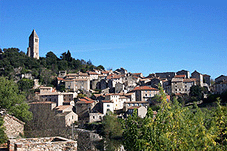 Olargues
OlarguesThis beautiful village lies at the banks of the river Jaur and at the foot of the Massif de l'Espinhouse. Through the covered stairway of the old Templar Commandery you can climb to the belvédère, from where you have a beautiful view over the surrounding area. On the opposite side of the covered stairway lies the Syndicat d'Initiative. Across the river Jaur lies a 13th century bridge. It is worth walking through the ancient streets and after every corner you get another surprise. From the ancient tower you have an exquisite view of the landscape and the town. There are several nice places to sit down for a tasteful lunch.
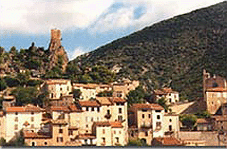 Roquebrun
RoquebrunThis little town, situated on a mountain slope, is also worth a visit. Just park your car at the parking place and stroll through its streets towards the ancient ruined tower which stands on the rock that gave its name, Roquebrun.In its surroundings there are orange trees, mimosa's and cactus plants. There is a "Jardin Méditerranéen", where over 2000 different species of cactus- and succulents grow. Apart from these there are also accacias and euphorbias. Roquebrun is situated on the banks of the river Orb, where you can canoe. The wines of the Orb valley are one of the best of the Languedoc.
Lodève
This large town has a gothic cathedral from the 13th century dedicated to St. Fulcran. This church has been fortified and has a 57 meter high, open tower. Beneath the choir is a crypt from the 6th and 7th century. Near the cloister is the bisshops palace from the 18th century, which is now the Town Hall. Set up in a beautiful mansion is the Musée Fleury, with exhibits of archeological and geological finds and paintings.
 Minerve
MinerveMinerve, which gave its name to an entire region in this part of the Midi, is beautifully situated on a rock surrounded by a gorge. Immediately, the visitor notices its strategic position from the parking place. It was almost impregnable, but was nevertheless taken by Simon de Montfort in 1210, during the crusades against the Cathars. The siege took 5 weeks, after which de Montfort succeeded in destroying the well by using a catapult. When the villagers saw that their water supply was gone, they surrendered. No less than 180 Cathars were burned at the stake. Next to the church of St.Etienne (11th century/12th century), you will see the monument to remember these martyrs.
In spite of its horrible past, it is a beautiful place to visit. Terraces overlook the gorge and here and there you can see a replica of the catapults, which reminds you of its fall in 1210. Minerve, however, is much older than the 11th century. The name already gives away its connection to the ancient cult of Minerva or Sulis-Minerva, which was popular even before our era. But even millions of years before, there was life here, as prove the many finds of dinosaur bones in the wonderful museum, which is definitely worth a visit. Besides prehistoric finds, you can also find archeological artifacts from prehistory and Roman & Visigoth times.
Further down the road you reach La Candela, the tower of the former castle of Minerve. This castle was demolished in 1636 at the order of Louis XIII. The tower dates from the middle of the 13th century and cannot be visited.
From Minerve, wonderful walks lead into nature. Close to the bridge which takes you back to the parking place, turn left and discover this wonderful restaurant with a lovely atmosphere and gorgeous view. This particular restaurant has milder prices than the ones in town.
 St. Guilhem le Désert
St. Guilhem le DésertThe main attraction of St. Guilhem le Désert is the abbey of Gellone, where a small piece of the wood of the cross is kept, on which Jesus was crucified around 33 AD. The abbey was founded by a certain William of Orange, duke of Aquitaine and friend of Charlemagne. William (Guilhem in Occitan) had been fighting bravely in Charlemagne's army but at the end of his career he sought a place, where he could devote himself to God. This place he found, in the valley of the Verdus, where the Verdu floats into the Herault. Especially between the 11th and 13th century, the abbey he founded experienced a rapid growth. Around the abbey a village rose up and in 1139, the body of the now holy William was placed in the abbey in an old marble sarcophagus. And because the village was on the route to Santiago de Compostela, the relics of St. Guilhem and the piece of the true cross attracted many a pilgrim.
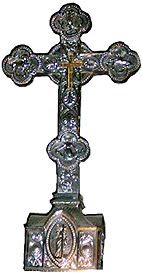 Already in the 14th century the abbey experienced decay. In 1569 the monastery was sacked by protestants during the Religious Wars. But the monks fled to Lodève and succeeded in hiding the relics beforehand. When the abbey was restored in the 17th century, the relics were rediscovered. After the French Revolution, the church was made into a parish church and the monastic life ended.
Already in the 14th century the abbey experienced decay. In 1569 the monastery was sacked by protestants during the Religious Wars. But the monks fled to Lodève and succeeded in hiding the relics beforehand. When the abbey was restored in the 17th century, the relics were rediscovered. After the French Revolution, the church was made into a parish church and the monastic life ended. Both the town as the abbey are very beautiful and worth a visit. On top of a bare hill lie the remains of the Chateau du Géant. Legend says that a giant lived there once, who terrorized the area.
Grotte de Clamouse
South of St. Guilhem le Désert are the caves of Clamouse. Although the entrance of the caves has been dug by human hands, the caves themselves were cut out by the waters of the Causse du Larzac. This river flows through the caves into the Herault, the river that gave the department its name. It is a wonderful journey passing many stalagmites and stalactites and worth a visit.